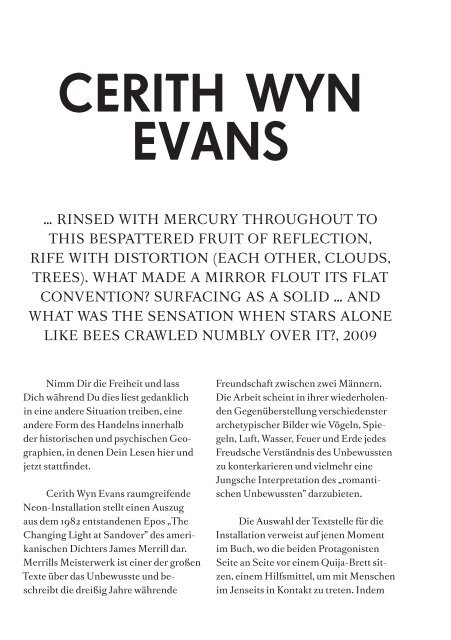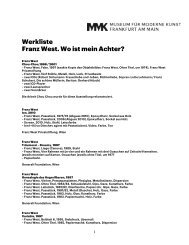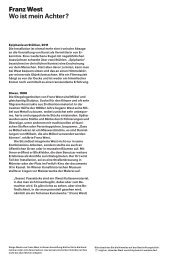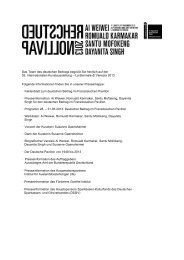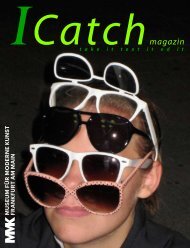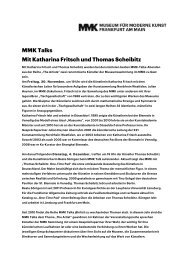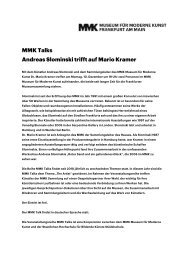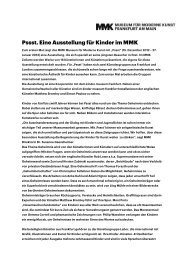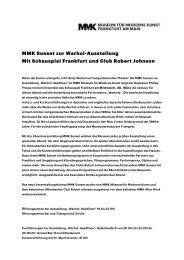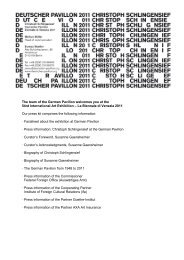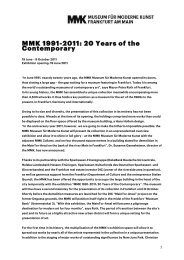CERITH WYN EVANS - Museum für Moderne Kunst
CERITH WYN EVANS - Museum für Moderne Kunst
CERITH WYN EVANS - Museum für Moderne Kunst
You also want an ePaper? Increase the reach of your titles
YUMPU automatically turns print PDFs into web optimized ePapers that Google loves.
Nimm Dir die Freiheit und lass<br />
Dich während Du dies liest gedanklich<br />
in eine andere Situation treiben, eine<br />
andere Form des Handelns innerhalb<br />
der historischen und psychischen Geo-<br />
graphien, in denen Dein Lesen hier und<br />
jetzt stattfindet.<br />
<strong>CERITH</strong> <strong>WYN</strong><br />
<strong>EVANS</strong><br />
… RINSED WITH MERCURY THROUGHOUT TO<br />
THIS BESPATTERED FRUIT OF REFLECTION,<br />
RIFE WITH DISTORTION (EACH OTHER, CLOUDS,<br />
TREES). WHAT MADE A MIRROR FLOUT ITS FLAT<br />
CONVENTION? SURFACING AS A SOLID … AND<br />
WHAT WAS THE SENSATION WHEN STARS ALONE<br />
LIKE BEES CRAWLED NUMBLY OVER IT?, 2009<br />
Cerith Wyn Evans raumgreifende<br />
Neon-Installation stellt einen Auszug<br />
aus dem 1982 entstandenen Epos „The<br />
Changing Light at Sandover” des ameri-<br />
kanischen Dichters James Merrill dar.<br />
Merrills Meisterwerk ist einer der großen<br />
Texte über das Unbewusste und be-<br />
schreibt die dreißig Jahre währende<br />
Freundschaft zwischen zwei Männern.<br />
Die Arbeit scheint in ihrer wiederholenden<br />
Gegenüberstellung verschiedenster<br />
archetypischer Bilder wie Vögeln, Spiegeln,<br />
Luft, Wasser, Feuer und Erde jedes<br />
Freudsche Verständnis des Unbewussten<br />
zu konterkarieren und vielmehr eine<br />
Jungsche Interpretation des „romantischen<br />
Unbewussten” darzubieten.<br />
Die Auswahl der Textstelle <strong>für</strong> die<br />
Installation verweist auf jenen Moment<br />
im Buch, wo die beiden Protagonisten<br />
Seite an Seite vor einem Quija-Brett sitzen,<br />
einem Hilfsmittel, um mit Menschen<br />
im Jenseits in Kontakt zu treten. Indem
sie den Becher auf dem Brett bewegen<br />
und mit der anderen Welt kommunizie-<br />
ren, stellen sie den Kontakt zu einem<br />
Herzog aus dem 2. Jahrhundert n. Chr.<br />
her. Er erzählt den beiden Männern von<br />
seiner Welt, wie sie funktioniert, über<br />
Hierarchien und Kämpfe. Nach einer<br />
gewissen Zeit äußert der Herzog den<br />
Wunsch, dass seine Gesprächspartner<br />
doch, wie er auch, sichtbar sein sollten<br />
und bittet sie, einen Spiegel auf den lee-<br />
ren Stuhl an der gegenüberliegenden<br />
Tischseite zu stellen, so dass er sie sehen<br />
könne. Genau an dieser Stelle beginnt<br />
das Zitat. Der alte, gesprungene und ver-<br />
schmutzte Spiegel verwandelt sich in ein<br />
transzendentes Symbol; auf der einen<br />
Seite ist er das Fenster in ein Paralleluni-<br />
versum, vielleicht ein Medium, um in<br />
einen anderen Bewusstseinszustand zu<br />
gelangen und auf der anderen Seite ein<br />
Mittel, durch das sich in die „reale Welt“<br />
schauen lässt. Durch ihn sieht man zwei<br />
Freunde und die Welt, in der sie leben: die<br />
Bäume und Wolken im Hintergrund. In<br />
dieser Szene schaut die „andere Welt“<br />
plötzlich auf sie zurück. Der Spiegel reflektiert<br />
nicht nur, sondern steht <strong>für</strong> eine<br />
Umkehrung der Subjektivität: Die Protagonisten<br />
schaffen Bilder, von denen sie<br />
glauben, dass sie jemand von der anderen<br />
Seite sieht, wenn er durch den Spiegel auf<br />
sie zurückschaut …<br />
Cerith Wyn Evans widmet sich in<br />
seiner Arbeit den Komplexitäten, die<br />
der Sprache und Phänomenologie inhärent<br />
sind. Er stellt Verbindungen zwischen<br />
dem gesprochenen Wort und der<br />
Literatur, zwischen Klang und Licht,<br />
Physik, Psychologie und Chiffren auf die<br />
Probe.<br />
Jan Verwoert schreibt in diesem Zusammenhang,<br />
dass Wyn Evans „einen<br />
spekulativen Diskurs über die Bedingungen<br />
und die Möglichkeiten führt, das<br />
Verhältnis von Erfahrung, Sprache und<br />
Wissen zu verändern. Seine Installationen<br />
sind Schauplätze, an denen eine solche<br />
Veränderung stattfinden kann. Jede<br />
Arbeit konstituiert ein Szenario, das uns<br />
herausfordert, einen anderen möglichen<br />
Blickwinkel auf die Welt einzunehmen.” 1<br />
Für … rinsed with mercury … hat der Künstler<br />
einen Neonschriftzug (in der äußerst<br />
neutralen Schrift Helvetica Neue Light)<br />
gewählt, um einen Satz zu bilden, den der<br />
Betrachter entweder als Fragment oder<br />
als Ganzes wahrnehmen kann. Die leuchtenden<br />
Worte schweben wie ihr Ursprung<br />
(die Stimmen aus dem Jenseits) im Raum.<br />
Sie bilden eine Oberfläche, die durch die<br />
Blicke des Betrachters im Hinblick auf<br />
ihre Tiefe und Bedeutung hinterfragt<br />
wird. Wyn Evans verwandelt die Neonschrift<br />
in eine transzendente Oberfläche,<br />
wie Merrill seinen Spiegel. Es geht nicht<br />
länger darum, zu bestimmen, ob das Ereignis<br />
real ist oder nicht, sondern um die<br />
Schaffung eines Grenzbereichs, der eine<br />
unendliche Anzahl von Erzählvarianten<br />
und Interpretationen eröffnet, nämlich<br />
die jeweils ganz persönlichen Erzählvarianten<br />
und Interpretationen.<br />
Man stelle sich eine Situation vor,<br />
in der man sich aller Wahrscheinlichkeit<br />
nach noch nicht befunden hat …<br />
Sophie von Olfers<br />
Übersetzung aus dem Englischen:<br />
Jeremy Gaines
1 Jan Verwoert, At Night they talk to each<br />
other on the Radio, in: Cerith Wyn Evans, Berlin<br />
2004, S.41<br />
<strong>CERITH</strong> <strong>WYN</strong> <strong>EVANS</strong><br />
(*1958 Llanelli, Wales —<br />
lebt in London, Großbritannien)<br />
… RINSED WITH MERCURY THROUGH-<br />
OUT TO THIS BESPATTERED FRUIT OF<br />
REFLECTION, RIFE WITH DISTORTION<br />
(EACH OTHER, CLOUDS, TREES).<br />
WHAT MADE A MIRROR FLOUT ITS FLAT<br />
CONVENTION? SURFACING AS A SOLID …<br />
AND WHAT WAS THE SENSATION WHEN<br />
STARS ALONE LIKE BEES CRAWLED<br />
NUMBLY OVER IT?, 2009<br />
Weiße Neonschrift<br />
<strong>Museum</strong> <strong>für</strong> <strong>Moderne</strong> <strong>Kunst</strong>,<br />
Frankfurt am Main<br />
Inv. Nr. 2009/49.1-5
<strong>CERITH</strong> <strong>WYN</strong> <strong>EVANS</strong><br />
… RINSED WITH MERCURY THROUGHOUT TO<br />
THIS BESPATTERED FRUIT OF REFLECTION, RIFE<br />
WITH DISTORTION (EACH OTHER, CLOUDS, TREES).<br />
WHAT MADE A MIRROR FLOUT ITS FLAT CONVEN-<br />
TION? SURFACING AS A SOLID … AND WHAT WAS<br />
THE SENSATION WHEN STARS ALONE LIKE BEES<br />
CRAWLED NUMBLY OVER IT?, 2009<br />
Permit yourself to drift from what<br />
you are reading at this very moment into<br />
another situation, another way of acting<br />
within the historical and psychic geogra-<br />
phies in which the event of your own<br />
reading is here and now taking place.<br />
Cerith Wyn Evans’ capacious neon<br />
installation portrays an excerpt from the<br />
American poet James Merrill’s epic “The<br />
Changing Light at Sandover” from 1982.<br />
Merrill’s masterpiece is one of the great<br />
oeuvres of writing about the unconscious<br />
mind, describing a thirty-year-long<br />
friendship between two men. Recurrently<br />
confronting all sorts of archetypal images<br />
like birds, mirrors, air, water, fire and<br />
earth, the work seems to counteract any<br />
Freudian understanding of the uncon-<br />
scious and rather provide a Jungian inter-<br />
pretation of the “romantic unconscious”.<br />
The choice of text for the installa-<br />
tion refers to a moment in the book<br />
where the two protagonists are sitting<br />
side by side in front of an Ouija board, a<br />
device to connect with the people in the<br />
afterlife. By moving the cup on the board<br />
and communicating with the other side,<br />
they establish contact with a duke from<br />
the Second Century AD. He tells the two<br />
men about the world, about how it functions,<br />
about its hierarchies and struggles.
At some point the duke feels his inter-<br />
locutors should, like himself, be visible<br />
and asks them to place a mirror on the<br />
vacant chair on the opposite side of the<br />
table so he can see them. This is exactly<br />
the moment where the quote sets in. The<br />
old, cracked and “bespattered” mirror<br />
turns into a transcendental symbol; on<br />
the one hand a window to a parallel universe,<br />
perhaps a vehicle to another state<br />
of consciousness and on the other, a device<br />
that can see into the ‘real world’. It<br />
sees the two friends and the world they<br />
live in: the trees and clouds behind them<br />
in the background. What happens in this<br />
scene is that suddenly the ‘other world’ is<br />
looking back at them. The mirror is no<br />
longer just reflecting, but stands for a reversal<br />
of subjectivity: the protagonists are<br />
creating images that they themselves believe<br />
someone from the other side sees<br />
when they look back at them through the<br />
mirror …<br />
In his work, Cerith Wyn Evans<br />
addresses complexities inherent in language<br />
and phenomenology. He tests<br />
connections between, for instance, the<br />
spoken word and literature, sound and<br />
light, physics, psychology and codes.<br />
Jan Verwoert writes that Wyn Evan’s<br />
“conducts a speculative discourse on the<br />
condition and potential to change the<br />
relationship of experience, speech and<br />
knowledge. His installations are venues<br />
on which such a change could take place.<br />
Each work establishes a scenario that<br />
challenges us to find another possible<br />
outlook on the world.” 1 In … rinsed with<br />
mercury … the artist has chosen neon lettering<br />
(in the radically neutral Helvetica<br />
Neue Light font) to build a phrase that<br />
the viewer can either experience in fragments<br />
or as a whole. The bright words,<br />
just like their source (the voices from the<br />
afterlife), are suspended in space. They<br />
form a surface, which the viewer’s glances<br />
are testing for depth, for meaning.<br />
Wyn Evans turns the neon lettering into<br />
a transcendental surface, just like Merrill<br />
does with his mirror. It is no longer about<br />
defining whether the event is real or not,<br />
but instead about creating a liminal space<br />
that allows an endless array of narratives<br />
and interpretations, namely everyone’s<br />
very personal narratives and interpretations.<br />
Imagine a situation that, in all likelihood,<br />
you’ve never been in …<br />
Sophie von Olfers
1 Jan Verwoert, At Night they talk to each<br />
other on the Radio, in: Cerith Wyn Evans, Berlin<br />
2004, p.41<br />
MMK MUSEUM FÜR MODERNE KUNST<br />
FRANKFURT AM MAIN<br />
<strong>CERITH</strong> <strong>WYN</strong> <strong>EVANS</strong><br />
(b. 1958, Llanelli, Wales —<br />
lives in London, Great Britain)<br />
… RINSED WITH MERCURY THROUGH-<br />
OUT TO THIS BESPATTERED FRUIT OF<br />
REFLECTION, RIFE WITH DISTORTION<br />
(EACH OTHER, CLOUDS, TREES).<br />
WHAT MADE A MIRROR FLOUT ITS FLAT<br />
CONVENTION? SURFACING AS A SOLID …<br />
AND WHAT WAS THE SENSATION WHEN<br />
STARS ALONE LIKE BEES CRAWLED<br />
NUMBLY OVER IT?, 2009<br />
White neon<br />
<strong>Museum</strong> <strong>für</strong> <strong>Moderne</strong> <strong>Kunst</strong>,<br />
Frankfurt am Main<br />
Inv. no. 2009/49.1-5


